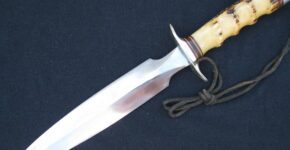

I have had this article on the back burner for some time now for a reason I will address later in the article, but with the chatter within the last year about WWII vintage Randall fighters possibly being delivered in something other than a C.J. Moore, H.H. Heiser, or Southern Saddlery sheaths, I decided to go ahead and do it.
Around nine or ten years ago, a noted collector and I began to have conversations about WWII vintage model 1’s we had seen in Marble’s style sheaths. Initially we thought that all of them were most likely replacement sheaths as the originals were likely lost to attrition over the past sixty-five plus years. I think in some cases they were exactly that, vintage replacement sheaths, but not all. The issue was some of the knives were in very good condition accompanied by a sheath in like condition, so other than a lost Moore, Heiser, or Southern Saddlery sheath, a plausible explanation was a sheath from a different maker was originally supplied with the knife.
Stories abound about Bo Randall’s difficulty in getting materials for his knife business during the WWII period. Did this difficulty also apply to sheaths? Evidence shows that this one area of procurement was not an issue, Bo could get sheaths. We know of the “Big 3” sheath makers, but what about these ‘oddballs’? After some discussions with Bob Gaddis, a bit of recondite information emerged and he confirmed that Bo did sell VL&A knives during WWII sans sheaths. The orders total in the hundreds with VL&A (Abercrombie & Fitch owned at the time) being the largest ‘dealer’ of RMK during the WWII years to the tune of maybe 15% of RMK’s total production, so it is very likely that some examples survived.
I think these sheaths are specific to VL&A as they supplied their own sheaths with most if not all of the straight blade knives from various manufacturers sold over the counter, save for the Marble’s brand. The earlier examples have two larger rivets at the throat and three smaller rivets, two located midway and one at the tip. Later examples have the two large throat rivets, and three staples where the smaller rivets of the early examples are located. Marbles style sheaths are very common for the period, but I don’t think any period Marble’s style sheath will suffice if you have a WWII Randall model 1 without an original sheath, and you might be contemplating pairing the two together. This scenario is the problem I said I would address later.
The discussion on the RKS forum let the “cat out of the bag” if you will, so now it must be addressed. I tried to tone it down there by discounting the possibility and existence of any quantity of these knives for what should be obvious reasons, to not give unscrupulous people the idea of matching a vintage sheath of similar Marble’s style to a knife and wa la, an ‘original’ AL&F supplied sheath with a WWII Randall model 1.
Another well known collector that helped in subsequent conversations and had some input on the subject possesses a wrist thong link knife that is most likely a VL&A Randall with a parent company A&F supplied sheath. He had also suspected for some time that these sheaths were originally supplied with the knives, he just wasn’t sure if from Randall. I also know of three later knives (probably later 1944 into 1945) that different collectors have that are probably VL&A knife/sheath combos also. Most important though, I know of one knife that is most definitely a surviving example because it came from the original owner!
Arriving in January 1944, Bill Platts had been at the shop for close to a year by the time the knife of discussion was made. His input and skill are evident with knives coming out of the shop being fairly consistent in blade grind and length, as well as handle shape and hilt shape. This particular knife exhibits typical characteristics for the time, with the handle shape falling between the cigar shape of earlier examples and the more “necked down” handle shapes of some later examples.
The real exciting part is the knife belonged to the original owner who states “I have cherished owning this Randall knife for 56 + years…..” Mr. Ganek “Enlisted in the Army Air Corp, while still in high school, just before graduation, June, 1943. I came home on leave in December of 1944, after receiving my pilot’s wings and flight officer’s bars. My dad and I purchased the Randall knife at V. L. and A. sporting goods store in Chicago.” Mr. Ganek was a B-24 Liberator pilot.
The knife remains in outstanding original and unused condition. A well preserved piece, it is complimented by the VL&A supplied sheath in like condition. One would most likely refer to this as a “Marble’s sheath”, as it is typical in appearance of the type. A handle keeper, slots cut for attachment to a belt, rivets at the throat, and three staples round out the construction. The leather is of decent quality and on par with Southern Saddlery, one of the Randall supplied makers of sheaths, and that of Mosser sheaths supplied primarily with Springfield Randalls. This VL&A sheath is decorated with Mr. Ganek’s handiwork and tooling as well as his name and initials. Mr. Ganek states, “This is the original sheath. I have added the detailing.”
Overall this is a handsome package and one of those items of Randall history that was thought lost to time. I consider these VL&A supplied sheaths a very interesting historical nuance of RMK. Bob Gaddis by his own admission did not spend too much time on sheaths during his research, so there has been some areas relative to this subject that have been unclear. One that is clear though, is VL&A did in fact supply sheaths for the vast majority of Randall fighters sold through their store.
